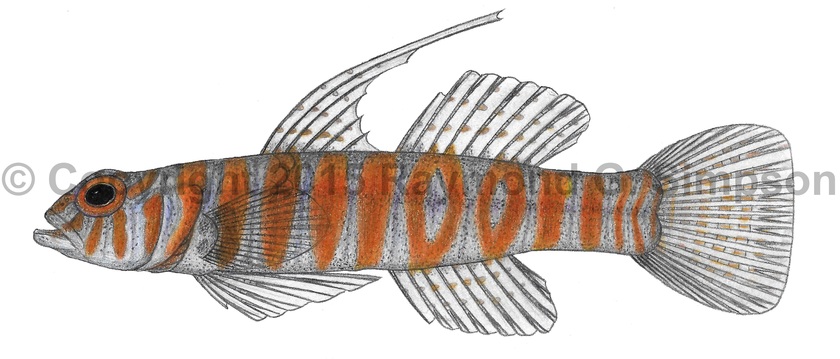
Common Name
Blue-gold Goby
Year Described
Bohlke & Robins, 1960
Identification
Dorsal Fin: VI, 9-10
Anal Fin: 9-10
Pectoral Fin: 15-17 (16)
Caudal Fin: 16-17
Lateral Line Scales: 25-27 (26)
Gill Rakers: 7 (first arch)
Vertebrae: 9+17 = 26 (total)
Body elongate and tapering to the rear. No lateral pores on head. Jaws with bands of teeth (conical teeth inward and sharp canines outside) but vomer and palatine without teeth. Anterior nostril tubular. Posterior nostril slightly raised and separated from anterior nostril. No frenum on upper lip. Tongue rounded at tip. Gill opening extends to ventral part of opercular flap. Head, chest, nape, and pectoral base naked. Naked area extends to origin of spiny dorsal fin. Belly scaled. Two separate dorsal fins. Anterior dorsal fin spines elongate. Pectoral rays unbranched.
Color
Body blue-gray with 12-13 orange to brownish-gold vertical bands from opercle to caudal peduncle. Thickest orange bands with blue-gray median bands. Head blue-gray with a orange blotch on cheek and a few bands radiating from eye. Eye orange. Paired fins translucent. Median fins transparent with scattered orange spots basally.
Size
A tiny species, reaching 25mm SL
Habitat
Coral reefs from 1-26m
Range
Collected in the Florida Keys, the Bahamas, Haiti, Bermuda, and the S. Caribbean.
References
Böhlke, J. E. and C. R. Robins. 1960. Western Atlantic gobioid fishes of the genus Lythrypnus, with notes on Quisquilius hipoliti and Garmannia pallens. Proceedings of the Academy of Natural Sciences of Philadelphia v. 112: 73-101, Pls. 1-3.